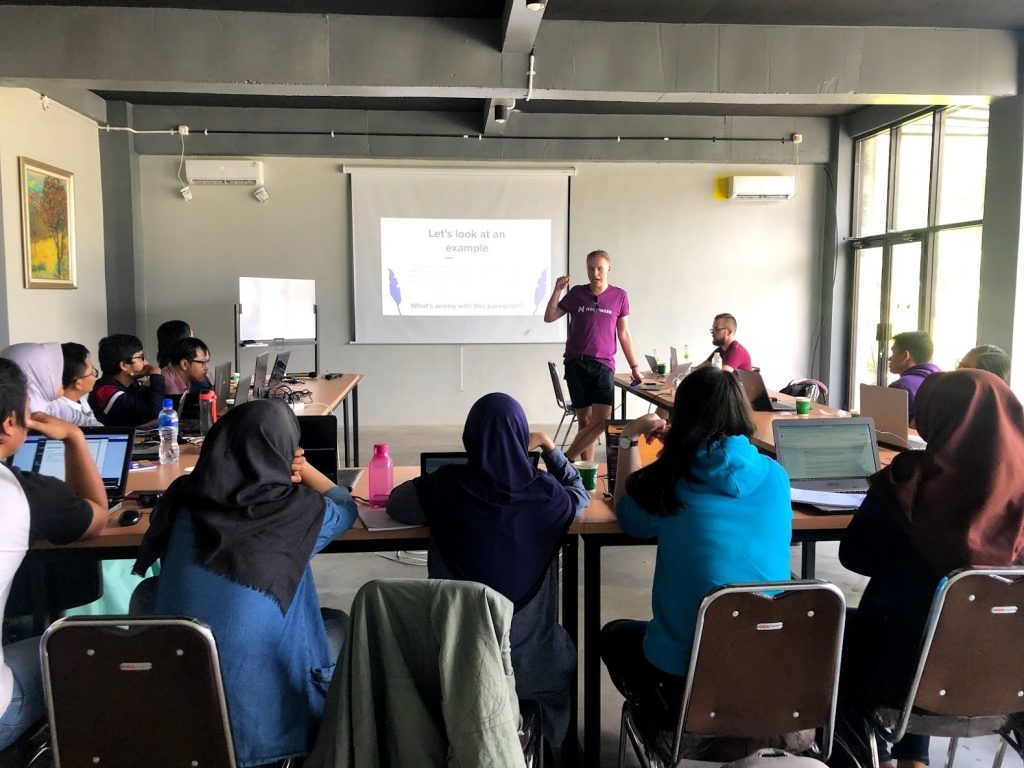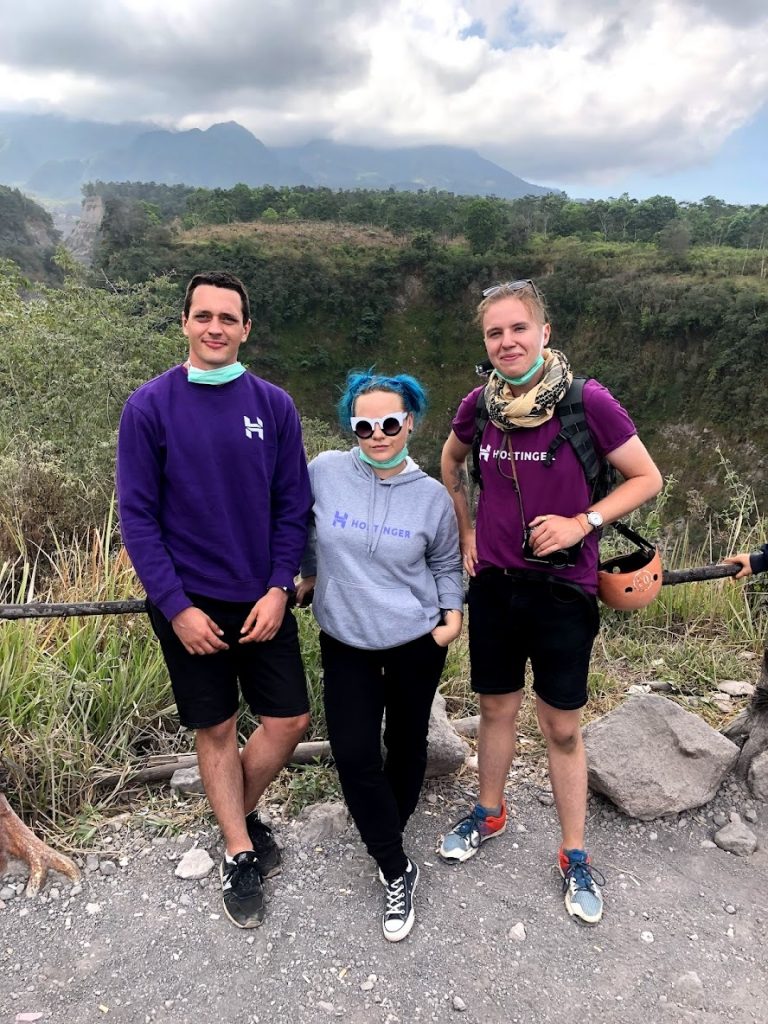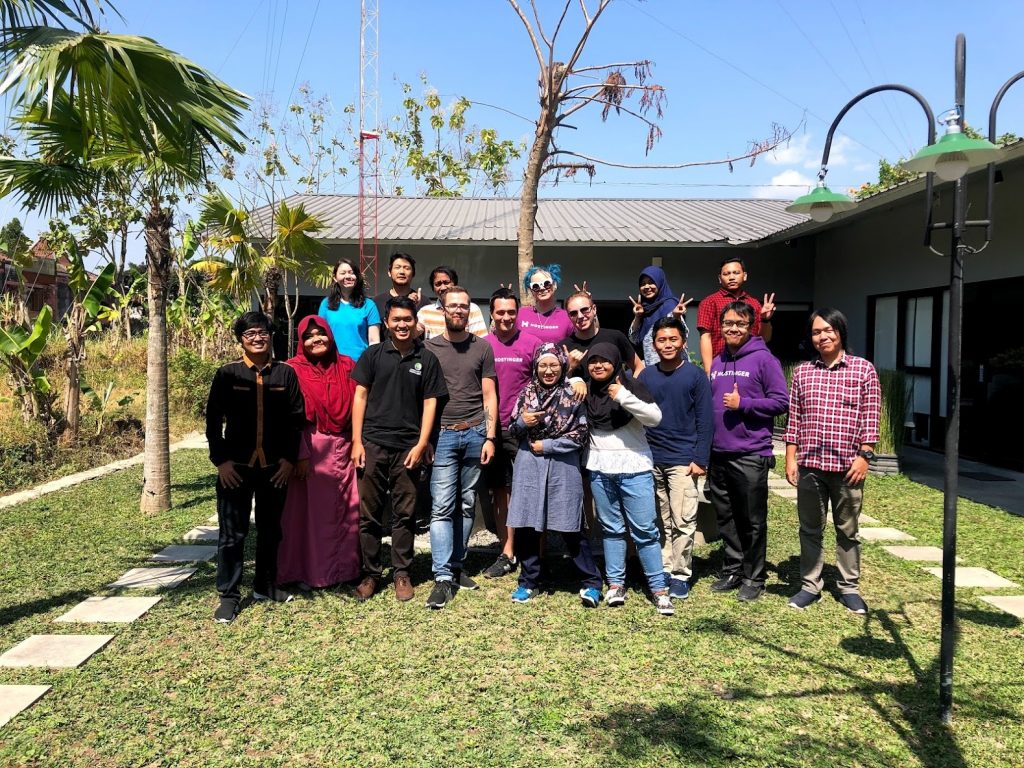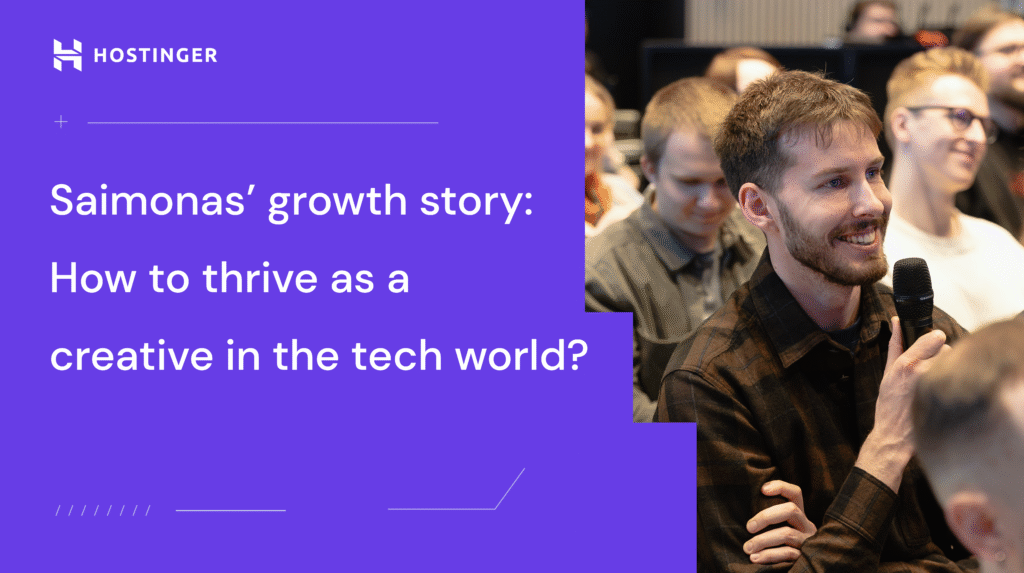Hostinger’s DNA: How Are We Nourishing a Multicultural Environment?

In the past few years, Hostinger has grown into a company with over 1 thousand employees, all spread across 35 countries. Even before the pandemic, global remote working was already ingrained in our company’s culture. As such, we strive to nurture our multicultural environment and make everyone feel heard – regardless of geography or cultural background.
Throughout the years, we have learned many lessons and achieved great success with our multicultural teams. We’re here to share our experiences and how we’ve overcome the challenges that came our way.
What Are the Advantages of a Multicultural Team?
For us, cultural diversity offers various benefits that enable us to both create a healthy work environment and optimize our services. Here’s what we’ve discovered:
Innovative Work Environment
In a multicultural workplace, people come in with different ideas and personality traits brought over from their cultures and lifestyles. More often than not, having access to multiple viewpoints can inspire creativity and out-of-the-box thinking.
In fact, a BCG survey found that diverse and inclusive teams are 45% more innovative than their homogeneous counterparts. The research examined 1,700 companies in multiple countries.
For Hostinger’s Squad Leader Emma Young, having a multicultural team means that “you won’t always approach tasks or issues the same way. You get to learn different cultures, ways of life, habits, things that are common or uncommon. It helps open your eyes and see things differently than you are used to.”
Local Market Insights
As a customer-obsessed company, we want to make sure that every client in all of our 39 locales is happy. Having a multicultural team helps us understand their needs and deliver exactly that.
“From a work-related standpoint, it’s really important that I get to understand how different our audiences are. My team members offer me invaluable insight into the readers, their preferences, and interests which helps me shape strategies tailored to each market individually.”
According to Hostinger’s Vita Klimaitė, working with people all over the globe makes her job as an SEO Content Manager much easier.
Cultural Exchange
For many Hostinger employees, having multiple cultures represented in the same team is exciting as well. It lends us the opportunity to see the world through our peers’ eyes from the comfort of our homes – or wherever we choose to work from. Before the pandemic, employees also had the opportunity to travel to other locales and experience the local culture.
For SEO English-Indonesian Translator Ariata, getting to represent her country in team-building activities is one of her favorite parts of the job. “It makes me feel happy and proud when I get the chance to introduce Indonesia to my coworkers – whether through sharing stories, my favorite spicy foods, or pictures of the Indonesian country.”
Increased Productivity and Profitability
A study by the Academy of Management Journal revealed a correlation between racial diversity in management and productivity. According to the research, a 1% growth in diversity in a tech firm led to increased productivity, with each employee bringing an added $729. The study also emphasized that companies with high diversity in upper and lower management have the best performance.
A McKinsey report on diversity and inclusion also supports this conclusion. The researchers discovered that companies with high ethnic and cultural diversity were more likely to perform 36% better financially than their peers. When nourished properly, multicultural diversity can have a positive impact on the vital aspects of a business. Of course, working in such an environment may also bring its fair share of disadvantages.

What Challenges Do Multicultural Teams Face?
We’ve asked our teams for their insight to answer this question. Here are several challenges to navigating a culturally diverse environment:
Communication Differences
Since Hostinger is a global and multicultural company, we mainly use English to communicate with one another. Despite speaking the same language, however, communication barriers can still arise. As we’ve all been raised in different cultural environments, it’s only natural that the way we express ideas and opinions also varies.
As a squad leader, Emma finds this aspect difficult to navigate, especially when practicing one of our Hostinger principles – Courage and Candidness. “With the cultural differences that our team has, each culture has very different approaches when it comes to talking to your manager, colleagues, team leads, etc. So figuring out what can be said and in what way takes a bit of time.”
Without proper knowledge and preparation, messages can get lost in translation and result in unintended consequences. Hence, adjusting your communication style is always important, whether you’re the one receiving or delivering the feedback.
Cultural Differences
In addition, there may also be obstacles in understanding that what works in one culture may not succeed in another. Such was the experience that Ariata faced when she began working at Hostinger. As a translator, she has to be able to localize marketing copy for the Indonesian market. However, there were several cases where she thought the material itself wouldn’t work with the audience.
“In Indonesia, we don’t really have what’s called a ‘summer sale’ because the weather is warm all year round. So I thought launching a campaign like that wouldn’t work here. It took some time to get them to understand that some campaign ideas would have to be readjusted.”
This issue can occur in other facets of a business. For instance, when recruiting a person from another country, the local talent pool’s skill set and work expectations may differ from where you live. These aspects are crucial to consider before posting a job online.
Time Zone Conflicts
For remote multicultural teams, finding the right time to have a meeting can be a hurdle – especially with people living on different continents altogether. “Any kind of team meeting we schedule is late in the evening for some and very early in the morning for others. It makes quality team buildings and extensive meetings a hard task,” says Vita.
Time zone conflicts can also make it difficult to work on deadline-sensitive tasks. If an employee needs immediate assistance or a second opinion, they may need to wait several hours to get a response from their coworkers.

How Hostinger Unifies a Multicultural Team
At Hostinger, we believe the perks of a multicultural work environment outweigh the challenges. Therefore, we always look for the best ways to nurture culturally diverse teams and sharpen these practices as we grow.
While there are many ways to achieve this, we believe the best practice is to start with the company principles. These are the values that govern how everyone at the company should complete their tasks and make decisions on an individual, team, and organizational level – regardless of where they’re from and what they look like.
“Hostinger principles are a constant metric to evaluate people and how they perform. Everyone has personal preferences, personality traits, and cultural aspects that shape who we are. Having the principles helps to unify our differences and align ourselves with Hostinger’s goals and vision,” says Laura Želvytė, our Content Production Team Lead.

While each principle has its own role, Customer Obsession plays a major part in bridging gaps whenever there are differing perspectives and approaches. For Laura, it’s a goal that brings all of us together.
“Customer Obsession is the understanding that we all work in order to help our customers and improve their online journeys. We apply who we are, how we think, what we do in order to produce the best possible output for our customers. All of the other principles tie in and further support Customer Obsession.”
There are several ways we strengthen Hostinger values in our multicultural teams. One of them involves holding team-level workshops every quarter and having open discussions on what the principles mean to each person. “These workshops help us all be on the same page. Everyone is an individual with different life and work experiences, so doing them helps us understand the why and how behind the principles,” says Laura. She also recommends incorporating the company principles into one-on-ones with direct reports and employee coaching programs. That way, they can focus on the areas they struggle with the most and find ways for improvement.
Best Practices for Working With Culturally Diverse Teams

Besides using company principles as a unifying guideline, here are some tried-and-true tips to work with and manage multicultural teams:
Prioritize Psychological Safety
Psychological safety is one of the metrics we use to measure a successful team. Introduced by behavioral scientist Amy Edmondson, it refers to how safe employees feel to take risks, ask for help, or point out problems at a workplace. In a multicultural team, psychological safety is vital to supporting diversity and inclusion. When each member can express themselves confidently without experiencing punishment, they will feel more welcomed and valued by the company.
Psychological safety allows tapping into the key benefit of a diverse work environment – innovation. If everyone feels safe to voice their opinions, they will be more open to experimentation and making mistakes, which can lead to creative outcomes.
At Hostinger, one of the ways we strive for psychological safety is through pulse surveys. We send them regularly to employees’ to check on their openness to taking risks, dependability on fellow colleagues, understanding of team structure, and job satisfaction. Doing so enables us to understand which areas we need to improve. Each team leader will get access to the results, so they can have an open conversation on how to support their members’ needs better.
Have an Open Mind
In his book 7 Habits of Highly Effective People, Stephen Covey writes, “Seek first to understand, then to be understood.” Before we can get others to follow our way of thinking, accept that they’ll have different approaches to certain situations.
“Not everything is going to be the black-and-white way that you see things. You have to be open to change, open to understanding, and welcoming to anything that isn’t the ‘norm’ to you,” says Emma. As such, leading with compassion is important. This can show up as actively listening without preconceived judgments or delivering feedback without blaming the other person. Besides smoothening communication, doing so can increase ownership and get rid of any accumulated anxiety.
On a related note, avoid taking things personally when receiving criticism. During a feedback session, focus on overcoming the problem and finding a win-win solution.
Get to Know Your Team Members and Colleagues
Our Learn and Be Curious principle doesn’t just apply to our work – it can also mean getting to know more about coworkers’ backgrounds and outlooks.
“Get to know their culture, their families, what they do for fun, and it will help understand and manage easier,” says Emma. “Learn to trust your team and they will trust you. You can’t come into a meeting, guns blazing, expecting your team to just bow down. It takes time and it can’t be forced or faked.”
For managers and team leaders, learning more about direct reports can offer more insight into how to lead them better. Vita recommends asking questions about their past professional experiences, from why they changed jobs, what an ideal team looks like for them, to where they see themselves professionally.
“We have biases and assumptions about how professional relationships work based on the work culture we know. You’d be surprised to see how different the expectations for a good team lead or manager are based on the background of your team members,” says Vita.
On top of that, she likes to suggest scheduling one-on-one sessions among team members, where they can bond and exchange knowledge. “It will be easier for everyone to fit that into their schedules as they won’t need to adjust too many time zones and the team will stay in close touch even without constant group calls.”
Adjust Your Leadership Styles to Each Team Member
One of the most essential tasks for a manager is to help team members feel comfortable in their job and achieve the goals they want to accomplish in the company. For Laura, one of the best ways to do so is to “adapt your managerial methods to each individual. Different people will need different coaching techniques, different communication approaches, and different motivations to keep them going.”
In other words, it’s crucial to incorporate Customer Obsession into your leadership philosophy, with the team members as customers. Start by figuring out what your direct reports need the most and let that information guide the next steps.
Host a Cultural Exchange Event
Having people do a show-and-tell of their cultures is another great way to promote inclusiveness in a multicultural environment. It allows employees to display their culture with pride and get to know one another better.
Last February through April, Hostinger’s Localization team launched an initiative where each locale’s representatives would present insights about their country and market. For Ariata, this lent her the opportunity to represent Indonesia proudly and educate her colleagues about marketing to the locals.
“I really wanted to do a great presentation and make sure all the correct information would be there. Not just about Indonesia itself but also the people’s buying behaviors and what influenced our cultural perceptions. That way, when the Marketing teams want to launch another campaign, they already know what to prepare for.”
Keep Experimenting
We believe that the practices above are the best starting points for working in a multicultural workplace. With that in mind, we also acknowledge that every team will come its own unique characteristics and challenges. There is no one-size-fits-all approach that can suit every dynamic, so finding the right system to facilitate your team’s needs may take some time and experimentation.
For some final thoughts, take a look at what Emma has to say about working with multicultural teams: “Take it day by day. I have seen my squad and other members of the Content Team open up and be vulnerable. They have started to give face-to-face feedback once we all started to understand each other and learn about each other.”
“From virtual coffee chats to company values workshops, just having lunch together, you name it, we’ve probably tried it. But it’s a slow and steady process – and I’m in no rush.”



